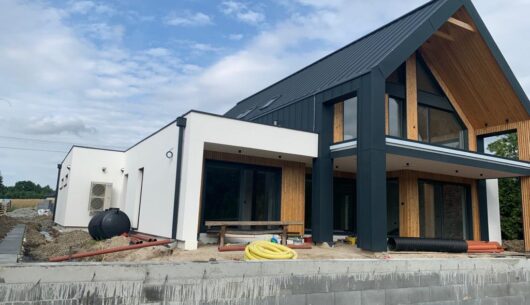Blog
What is a foundation slab?
Table of contents
- Foundation slab – what is it?
- What layers does the foundation slab consist of?
- Advantages of foundation slabs
- Foundation slab in modern homes
The foundation is one of the most important elements that are created during the construction of various types of facilities: residential, industrial or commercial. There are different types of structures of this type, and one of them is the foundation slab. It is increasingly used in construction. Check what it is characterized by, what layers it consists of and what its advantages are.
Foundation slab – what is it?
It is a type of foundation, usually made of reinforced concrete, which transfers the loads caused by the weight of the building to the ground. Initially, it was used especially on difficult terrain, i.e. with poor load-bearing capacity.
Nowadays, however, more and more often this type of structures are built even on stable ground, because investors appreciate them due to their numerous advantages. The specificity of the solution meant that it was initially used primarily in Scandinavia. Currently, they are being implemented on a large scale in architectural and construction projects carried out throughout Europe, including Poland.

What layers does the foundation slab consist of?
Once you know what a foundation slab is, it is also worth checking what elements it consists of.
The structure is made of the following layers:
- substructure – made of aggregate, i.e. sand or gravel;
- pospółka – from compacted sand with a thickness of 15 to even 30 cm;
- thermal insulation – it is made of insulating material;
- reinforced – a reinforced concrete slab that has a height of 12 to 20 cm;
- Spout.
Steel reinforcement is used to prepare the foundation slab. It is spread over the entire structure. Therefore, in order to reduce costs, a different material is used in places where load-bearing walls will be built (steel meshes and bars) and a different one in other parts of the building (concrete enriched with reinforcing fibers). The reinforcement itself is made in the upper and lower layers of the slab.
Advantages of foundation slabs
The most important advantages of foundation slabs are the following aspects.
- Accelerating construction
The construction of a foundation slab takes much less time than the construction of the so-called deep foundations. The entire procedure, depending on the size of the building, usually takes several days.
- Creating a good quality insulation layer on the foundation
The foundation slab, due to its structure, is very well insulated. It avoids thermal bridges. As a result, it effectively reduces the costs associated with the operation of the building when it is put into use.
- Can be used on soils with poor load-bearing capacity
The foundation slab can be used both on good quality soil and on ground with deteriorated load-bearing parameters.
- Reduce the risk of cracking of walls and foundations
The use of a slab structure allows you to reduce the risk associated with cracking of walls and foundations. They are most often caused by uneven distribution of the weight of the structure on the foundation.
The numerous advantages of the foundation slab make investors more and more often decide to use it. Where is this design solution most often used?
Foundation slab in modern homes
The foundation slab was initially used in buildings built in Scandinavia, a country where houses are mainly built in a frame structure. Therefore, currently in the western part of Europe or in Poland, this type of foundation is most often used in wooden buildings. Due to the fact that they are energy-efficient and often even passive, the foundation slab has a positive effect on their insulation parameters.
It is also a structure that allows for even distribution of loads resulting from the weight of the building. Its use accelerates construction works and reduces heat loss in the future, which is why it is used more and more often in modern construction.